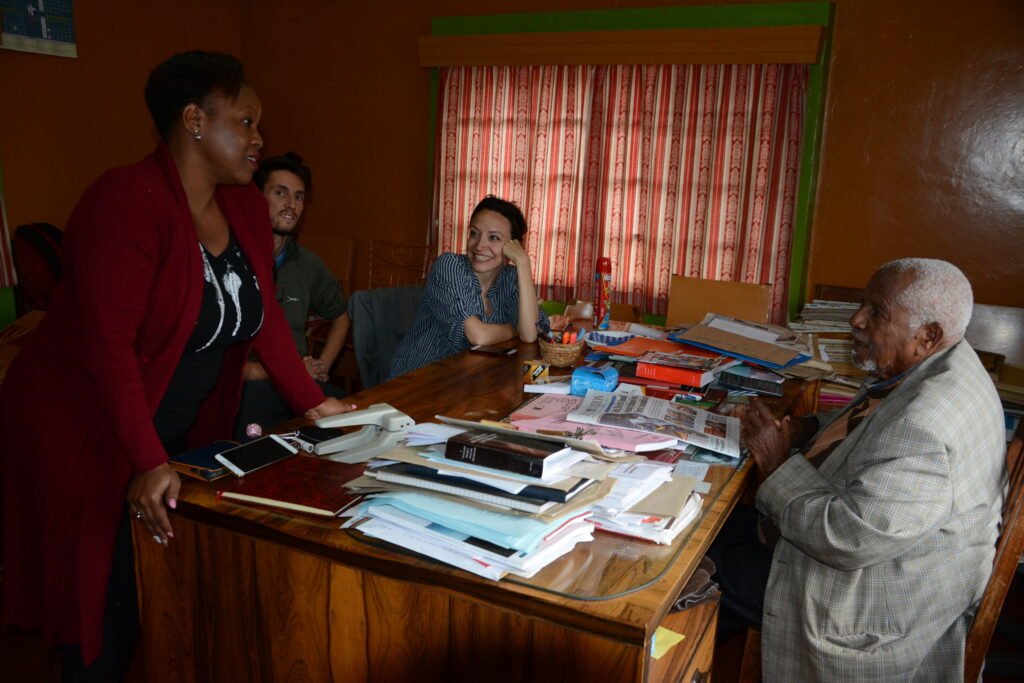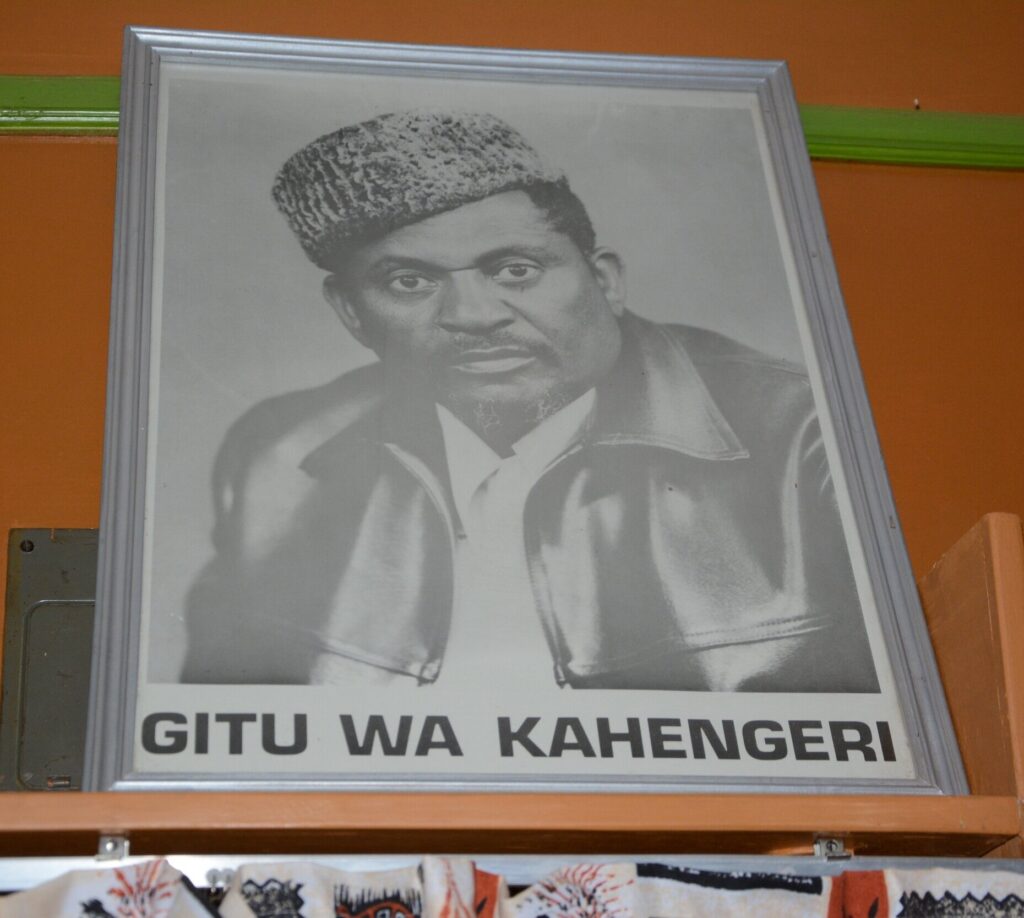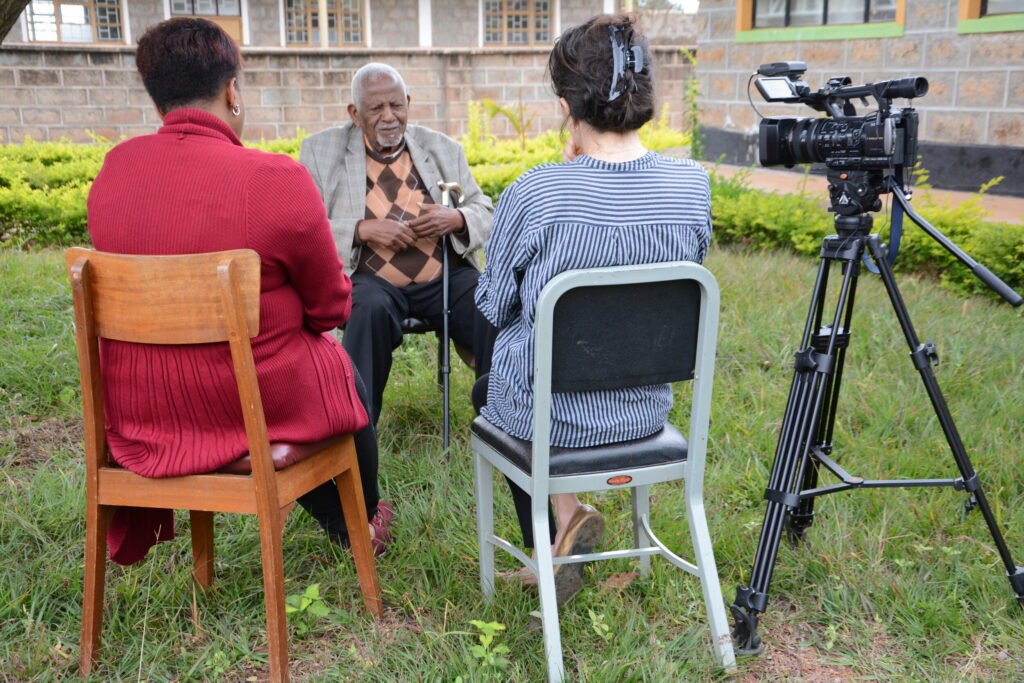EMERGENCY EXHIBITION
SITES AND STORIES OF THE MAU MAU CONFLICT
In January 2020 we held our first physical exhibition, Emergency: Sites and Stories of the Mau Mau Conflict. We held the exhibition at The Africa Centre, alongside our ‘Changing the Narrative’ event on 11th and 12th January. The exhibition comprised three sections showcasing our work uncovering and creating work relating to the Mau Mau Emergency, which took place in 1950s Kenya. Below is a digital tour of Emergency – you can also find a digital version of Emergency’s exhibition guide here and all our digital resources here.
Since 2020, this page is updated to reflect MBC's recent field work activities and reconstructions.
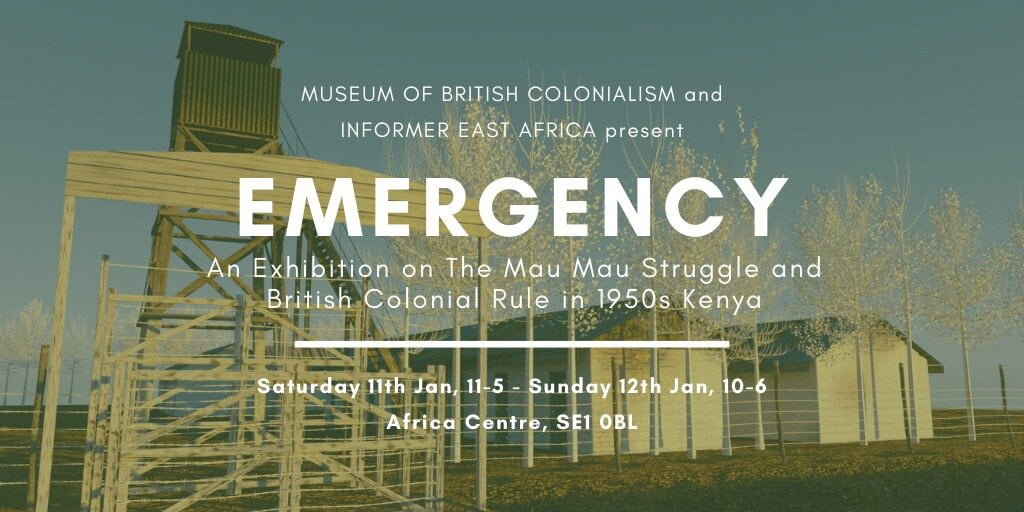
Emergency included a presentation of our field work in the Central Region, Kenya, 3D site reconstructions created in partnership with African Digital Heritage, and oral history interviews with veterans of the Emergency. The UK event was made possible with the generous support of the UCL Centre for Critical Heritage. We hope to hold a similar exhibition – and accompanying event – in Nairobi in the coming months so keep your eyes peeled on our social media for more updates!
EMERGENCY SITES
In 2018, we created a digital map of the sites of the ‘pipeline’, the network of detention centres and work camps set up by the British colonial administration to quell the Mau Mau fight for land and freedom from British colonial rule. We created this map using a digital mapping platform (Carto) when we found it difficult to visualise the scale and reach of detention camps across the country.
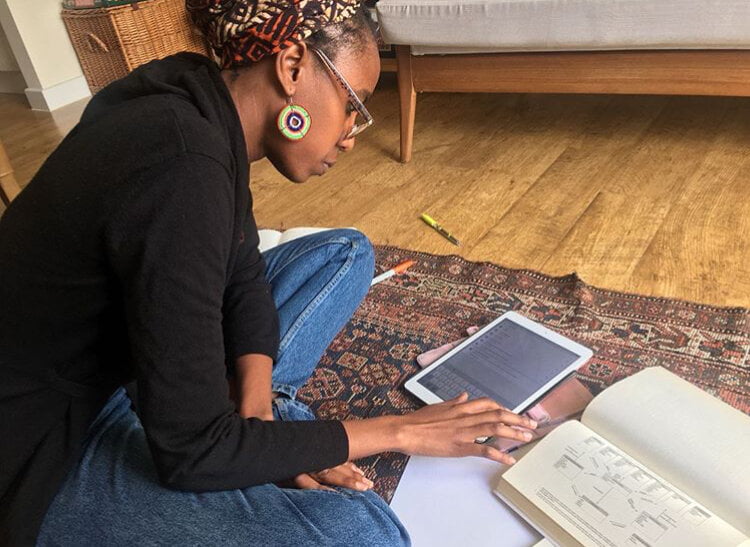
This photo shows MBC team member Chao first developing the map in another team member’s flat, by analysing material from Caroline Elkins’ book Britain’s Gulag (2005) and overlaying mentioned camp sites onto a digital map of Kenya. The points indicated on the map are not the exact locations of the camps, but are representations of the towns in which the camps were located.
The purpose of creating this was to provide a more compelling and digestible representation of the pipeline that would help audiences – and our own team – visualise the nature of the conflict and the scale of the operations.
Though we have visited several sites related to the Mau Mau conflict, Emergency focused on presenting our work at two former detention camps in Nyeri county, both repurposed as schools. You can see more of our work at Aguthi, Mweru, and other sites here.
AGUTHI WORKS CAMP (KANGUBIRI GIRLS HIGH SCHOOL)
Aguthi was one of a number of work camps in the Central Region used to detain individuals and families considered to have ‘soft’ Mau Mau sympathies. Those who were considered ‘hardcore’ – ‘Blacks’ – Mau Mau would be taken to far off exile camps in harsh, remote areas of the country such as Lamu island or Tsavo desert.
Once they were considered rehabilitated, detainees would then be transferred to work camps such as Aguthi which were closer to home, and were often the last steps in the pipeline before one would be released back into society. After independence, detention camps around the country were either dismantled or turned into secondary schools or prisons. Today, the grounds and structures of Aguthi Works Camp have been repurposed into a girls secondary school known as Kangubiri Girls High School.
From local oral history, the word Kangubiri is said to be a Gikuyu corruption of the English phrase “You can go free”, rumoured to have been uttered by camp commandants when detainees were considered ‘cured’ of Mau Mau sympathies and allowed to reintegrate into society. This attests to the fact that Aguthi works camp was indeed one of the last stages of the pipeline.
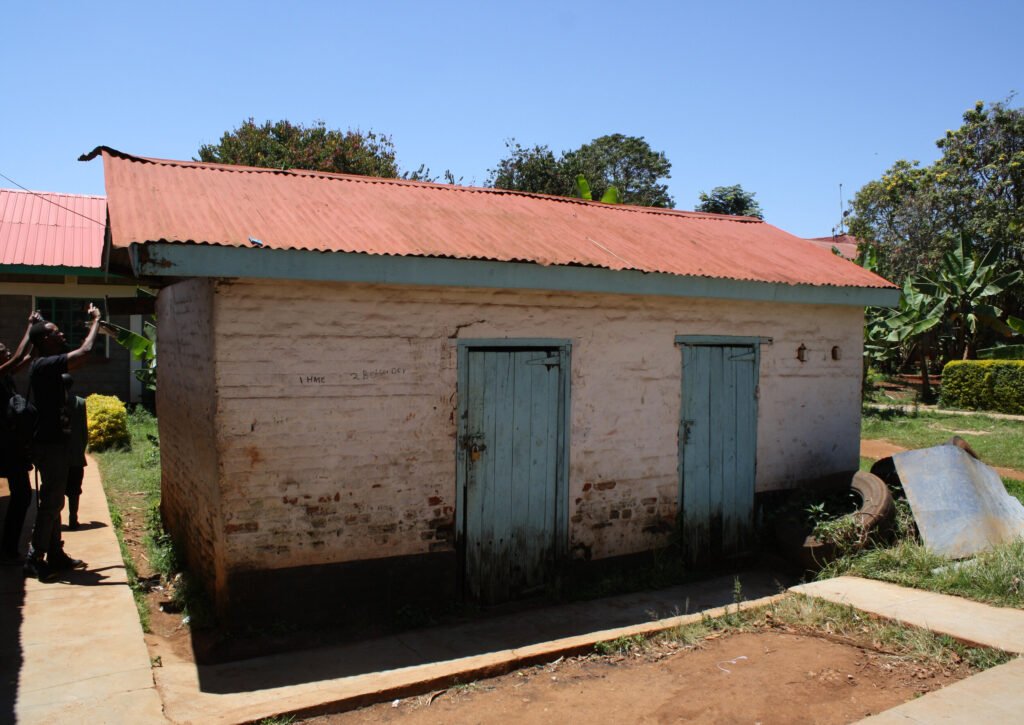
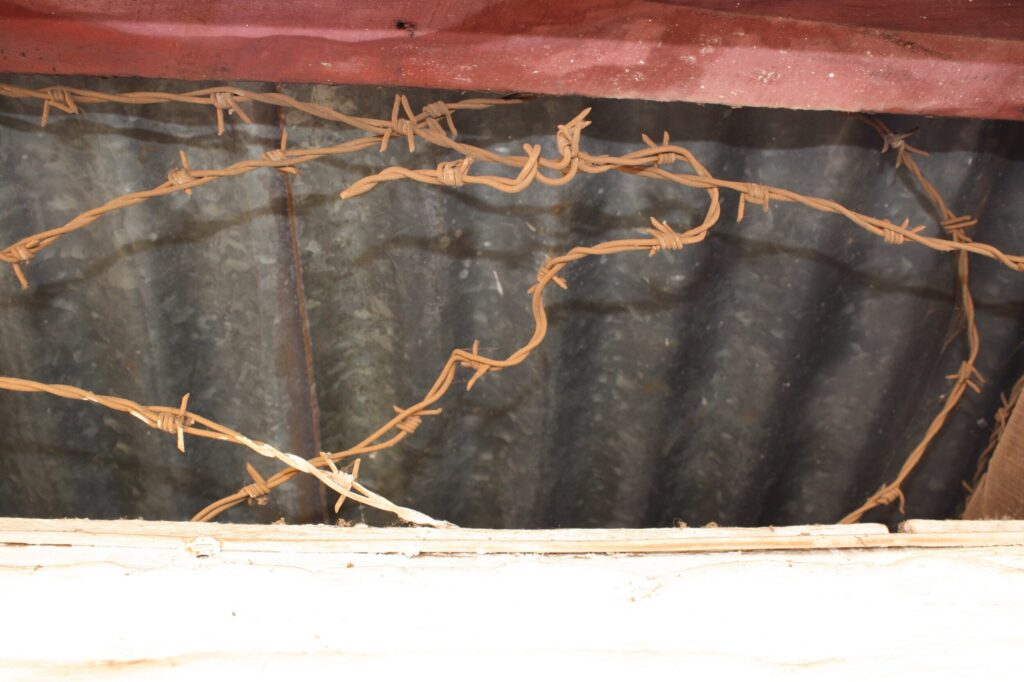
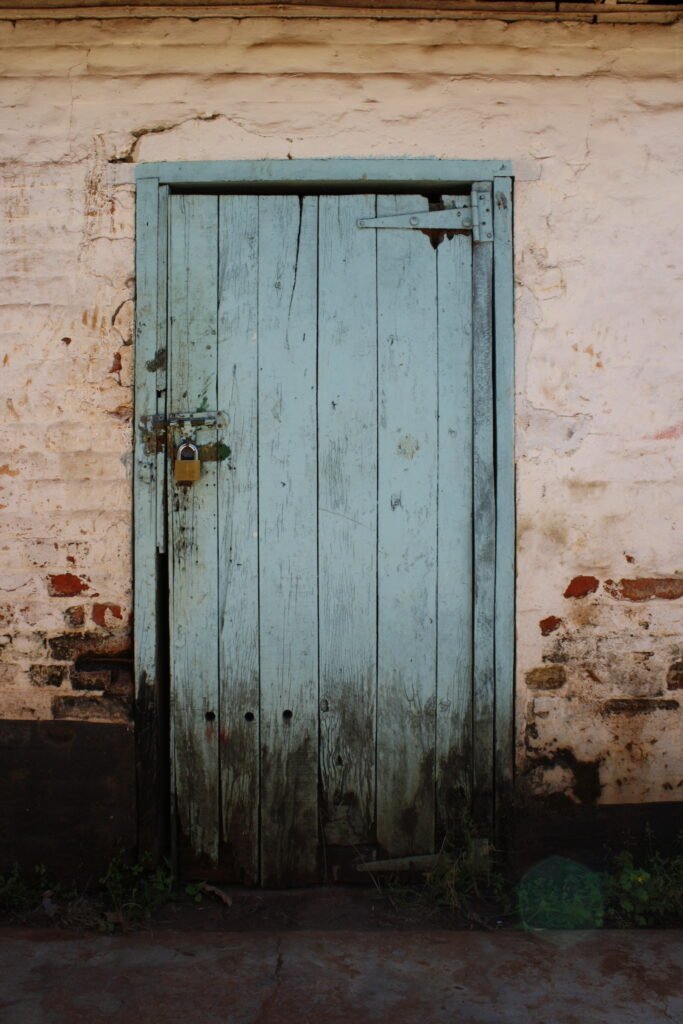
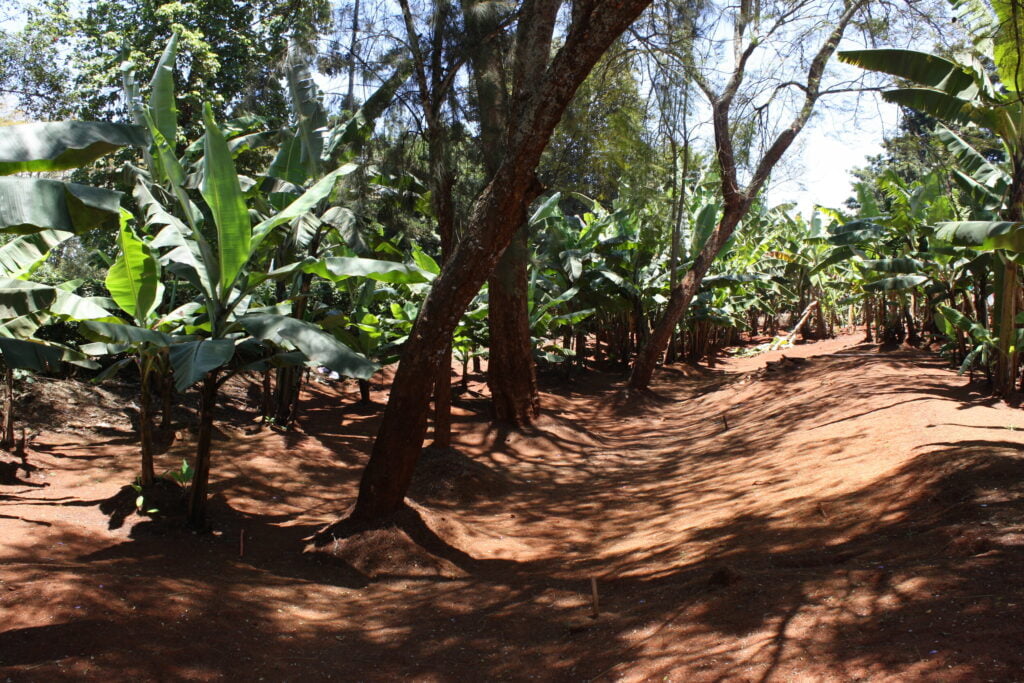
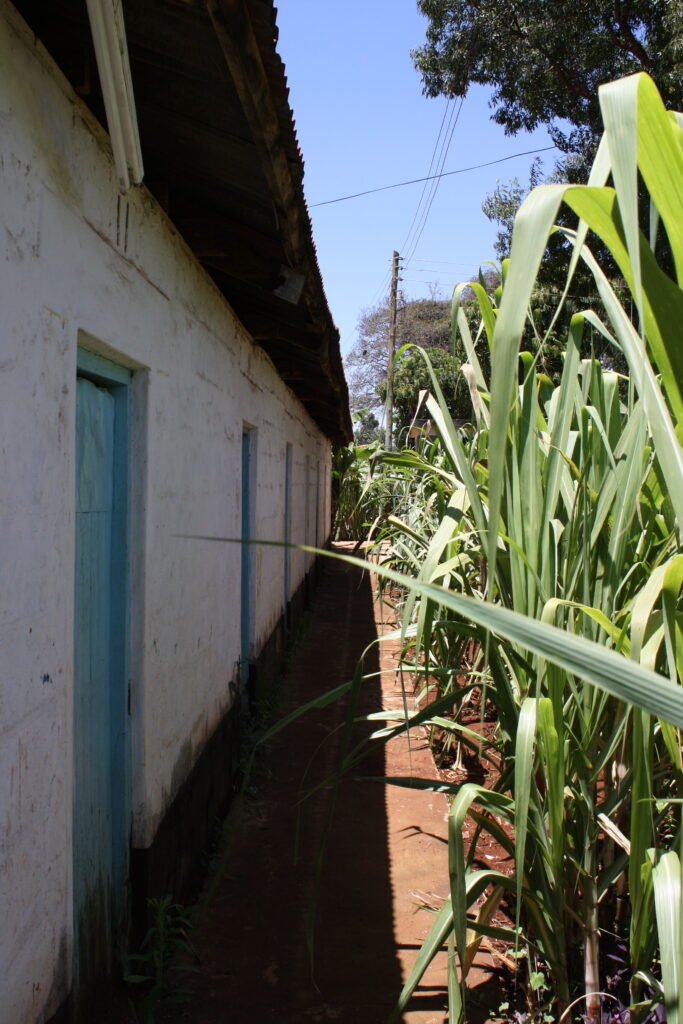
MWERU WORKS CAMP (MWERU HIGH SCHOOL)
Like Aguthi, Mweru was also a works camp in the Central Region that has been turned into a high school – Mweru High School.
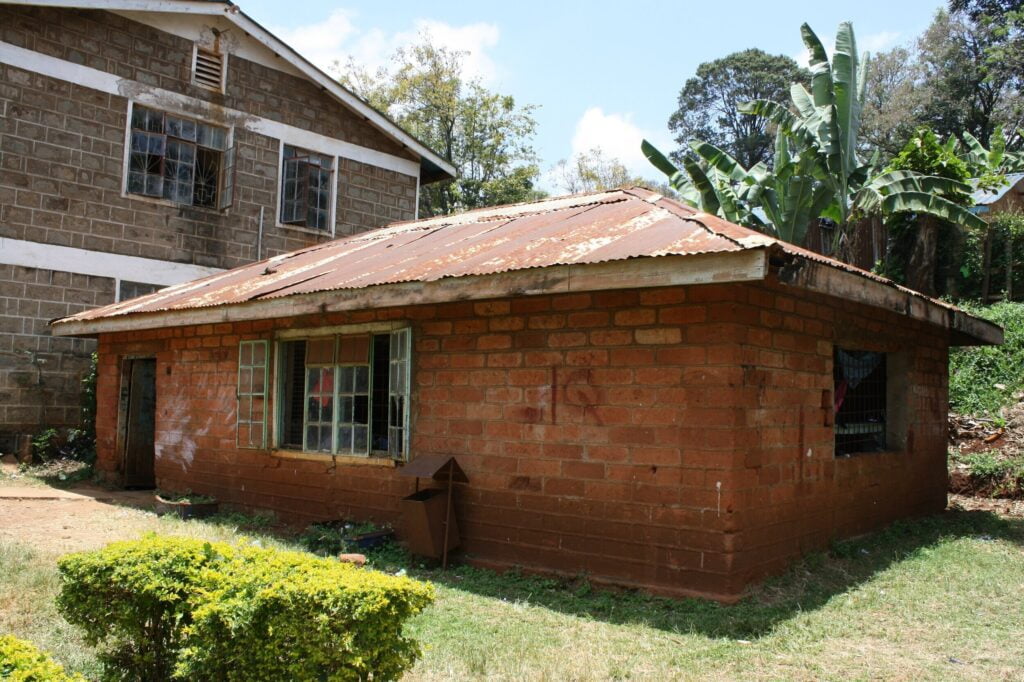
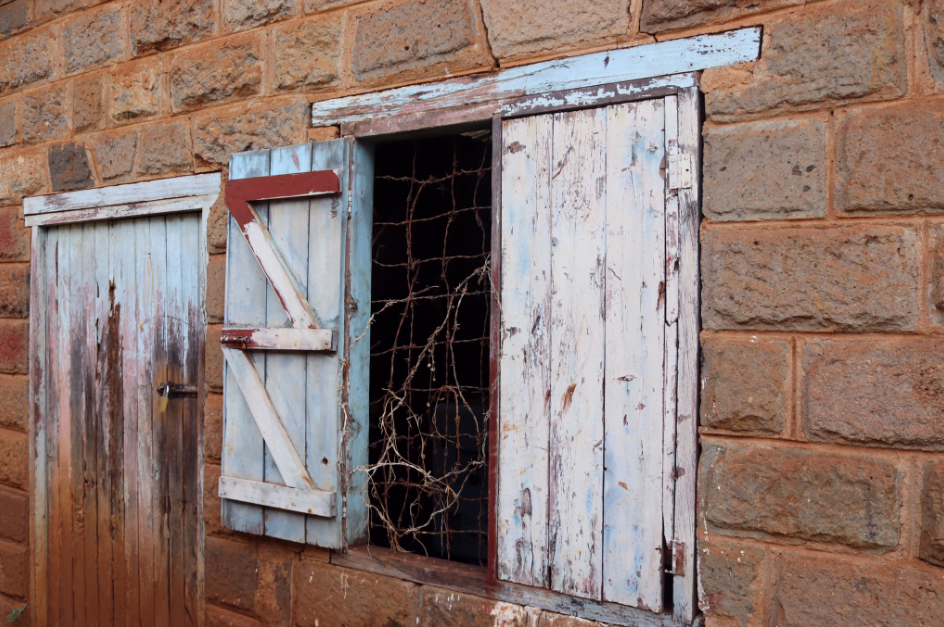
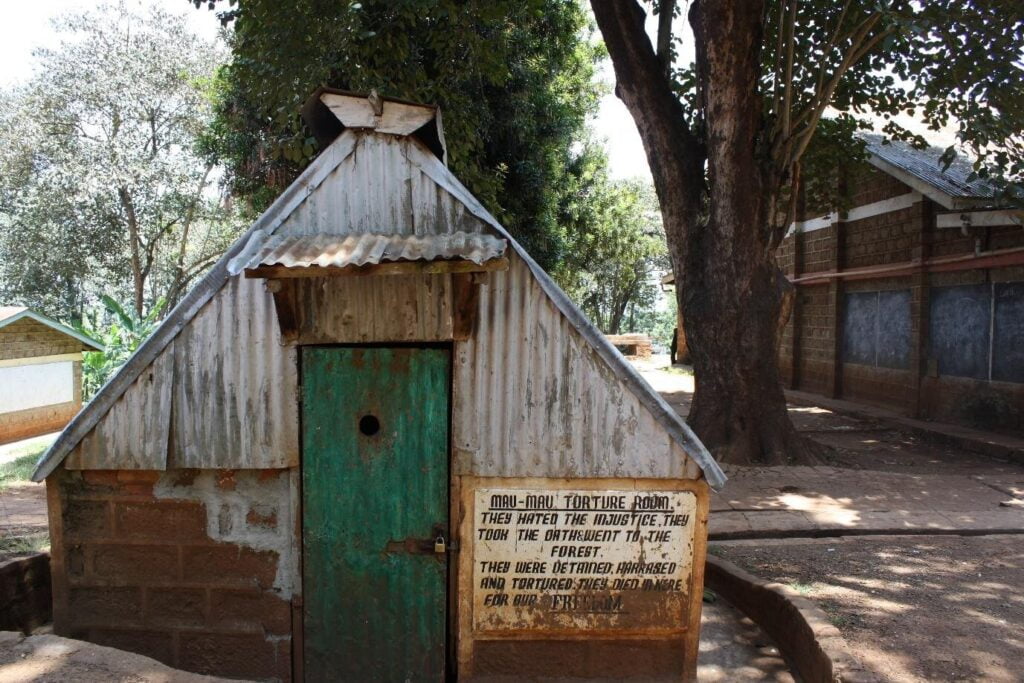
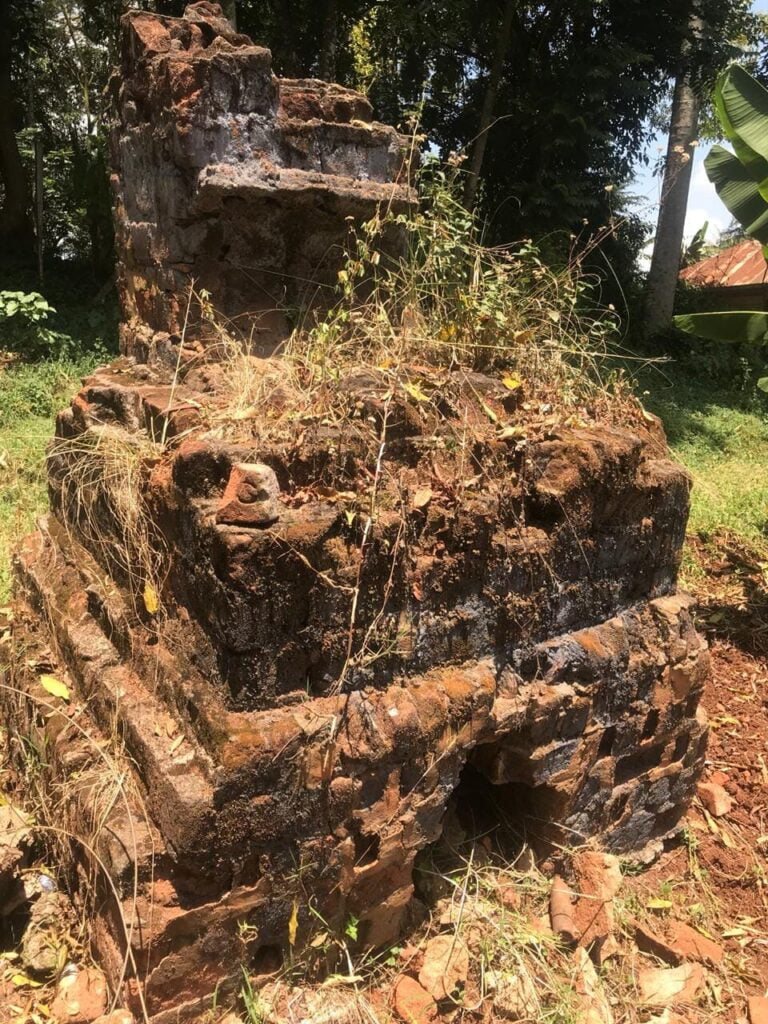
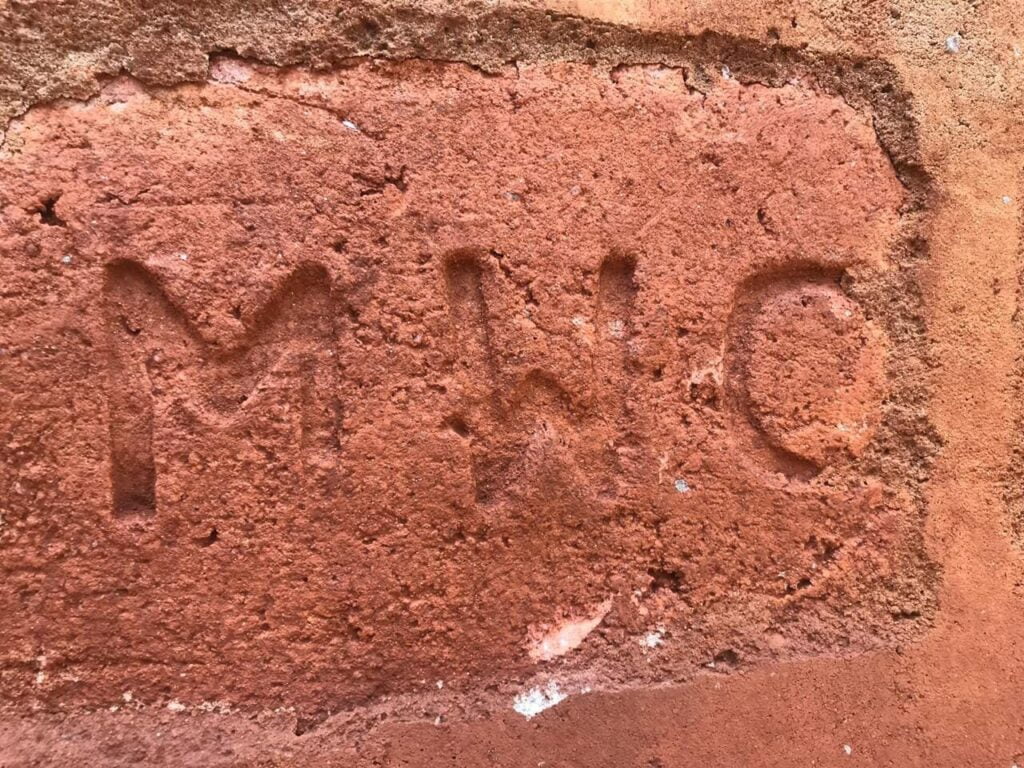
KIAMBICHO DETENTION VILLAGE
In 2022, the MBC team visited Kiambicho village one of the few remaining sites where women, children and elderly men were held during the emergency. Many colonial administrators saw women as key actors in sustaining Mau Mau efforts. ‘Villagisation’ was a direct effort to break this support and punish those involved. Gĩkũyũ, and Gĩkũyũ-speaking women, their children, and elders were the main targets. They were forcibly resettled into 854 enclosed camps across central Kenya throughout 1954. By physically securing this wider population, the British security forces and their administration could control their movement.
DIGITAL RECONSTRUCTION
Since MBC’s conception, we have privileged digital models of documentation and presentation of information. One of the primary reasons for this is that we have always been an online-first space, and we see digital tools and media as a way to reach wider audiences in different geographic locations, as well as able to engage audiences at different levels of literacy, expertise, and age. As a volunteer organisation working across Kenya and the UK, a digital approach has also allowed us to share our work without having to possess physical collections.
So far, we have employed digital tools to present content in two main ways: interactive maps and 3D digital reconstructions. Our primary sources of information include:
- Visits to former camp sites to document existing camp structures and remains that still stand today
- Oral history from local community and Mau Mau veterans
- Archival records, including photographs, books, maps, videos, etc.
Below are detailed looks at four digital reconstructions created in 2019 from the two different camps we are now familiar with, Aguthi and Mweru.
AGUTHI WORKS CAMP
Our first 3D digital recreation focuses on the watchtower, trench, and entrance of Aguthi Works Camp. The uniqueness of this model, when compared with the others, is that none of the structures presented remain intact today; this digital model was created entirely from archival photos and oral interviews.
Below you can see the site as it is found today, with MBC contributor Moha standing at the approximate location of the watchtower. Our digital recreations of the watchtower and camp entrance show the site from ground level as well as from an aerial view. These models incorporate buildings from the former site that still remain today, and combine these with the watchtower.
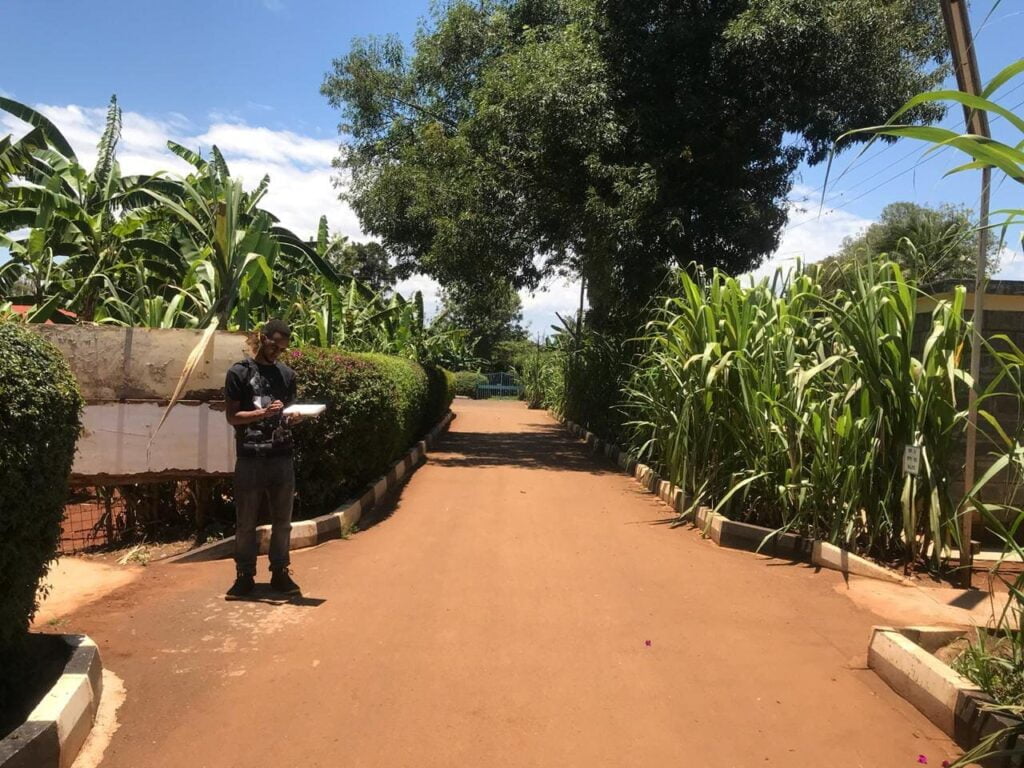
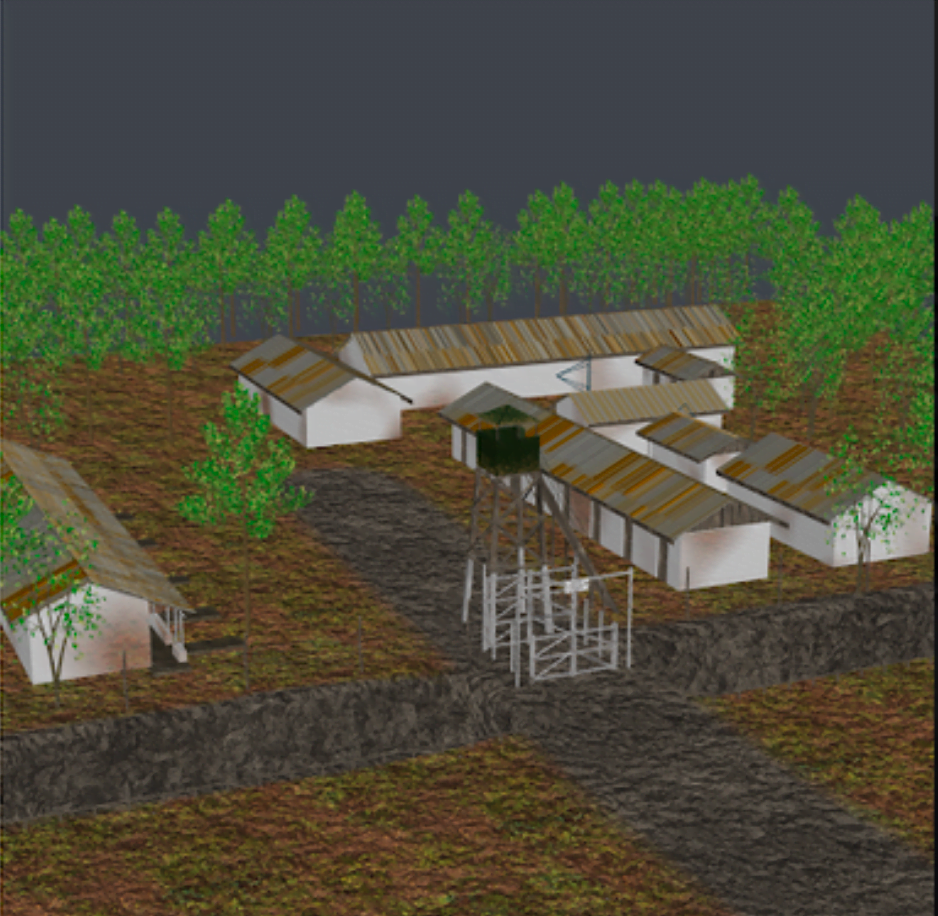
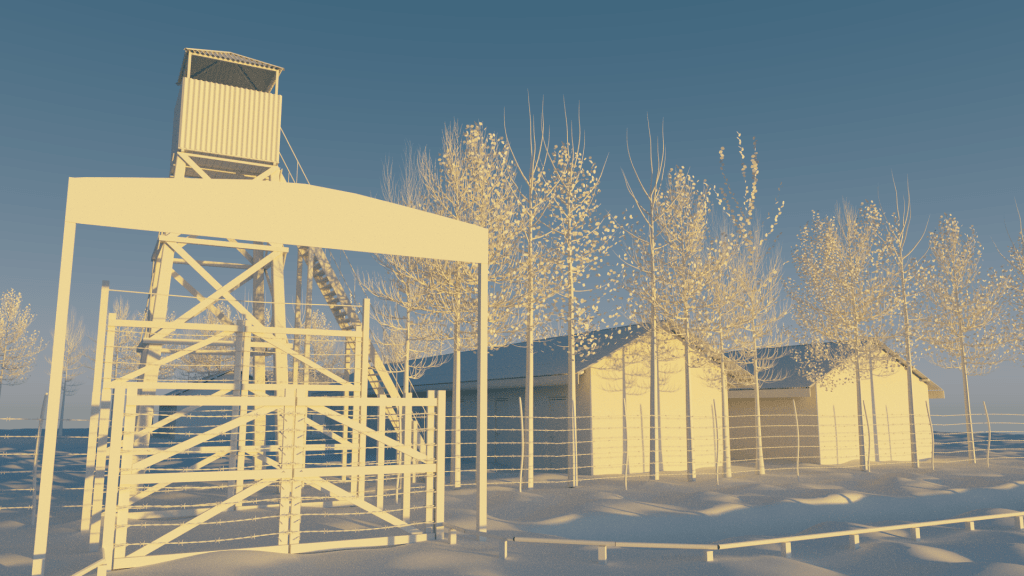
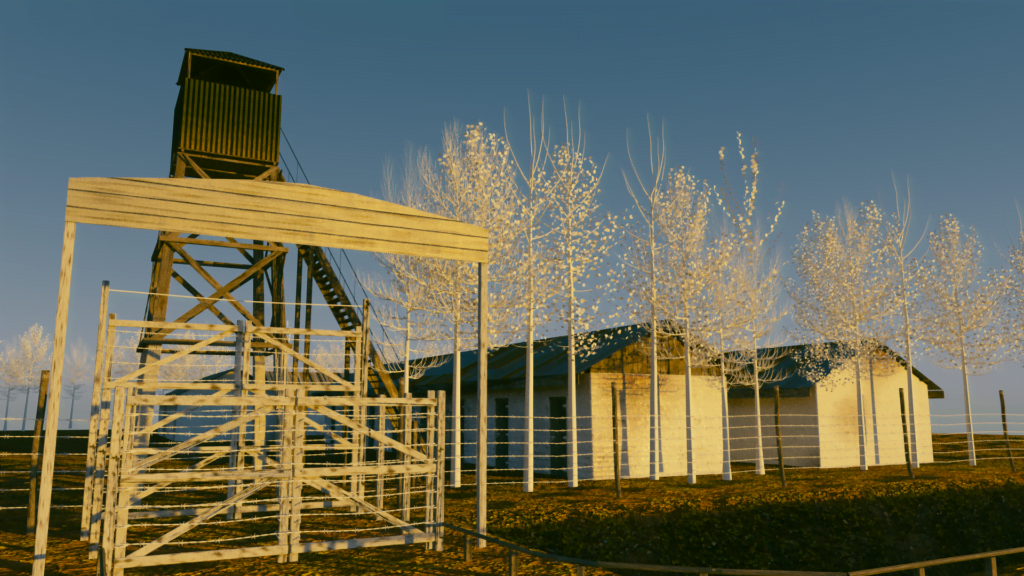
From our conversations with the local community, we were able to gather that the school had not altered the original buildings of the solitary confinement cells significantly.
The school caretaker mentioned that originally, the doors had three spy holes at the top so that camp officers were able to look into the cells, but the school had turned the doors upside down during renovation. Aside from this modification, the buildings’ exteriors were painted to match the school’s theme.
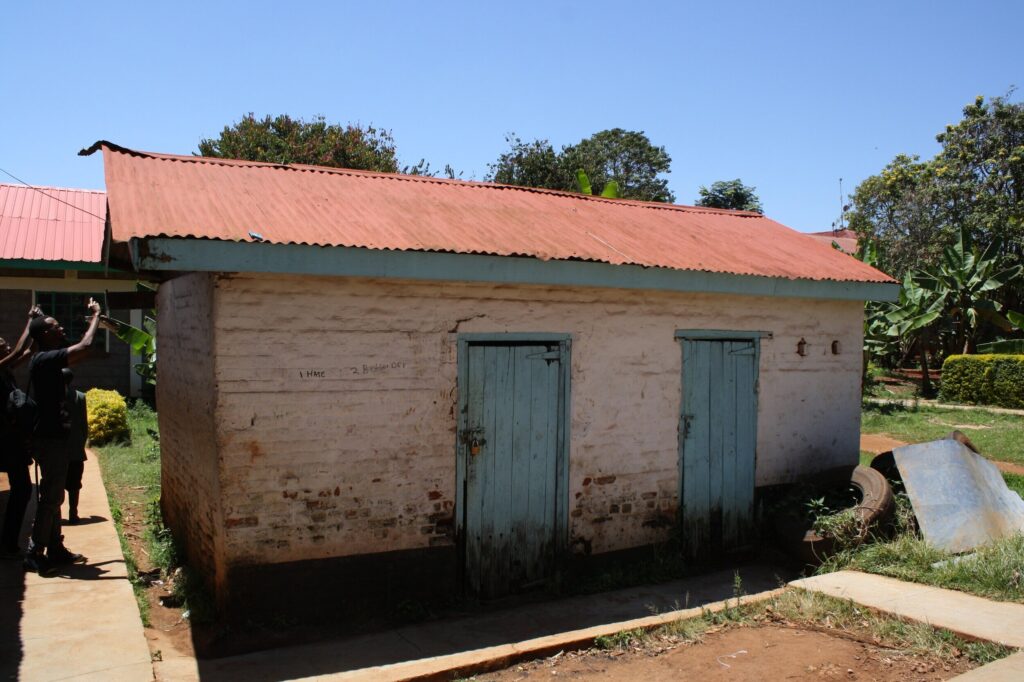
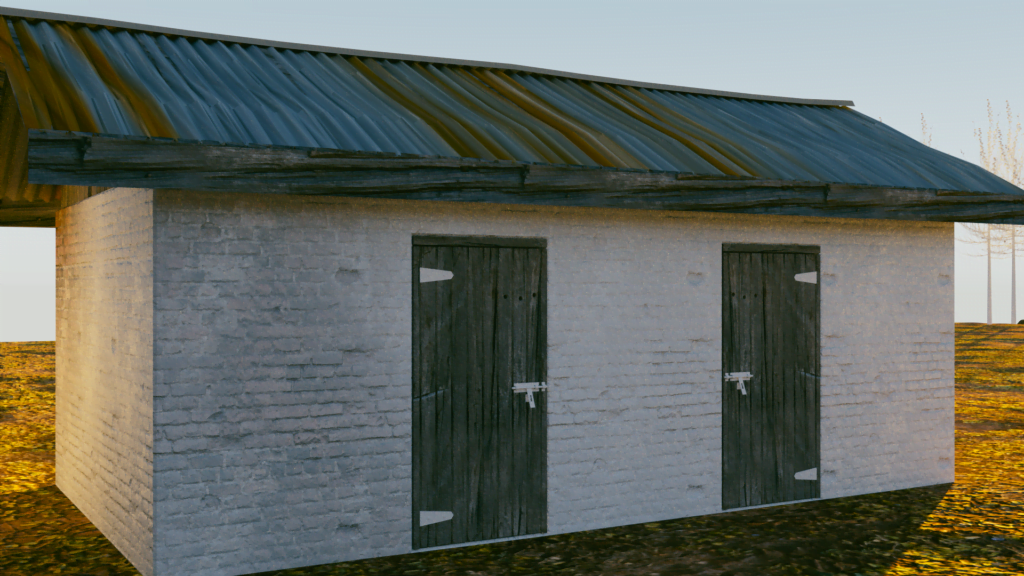
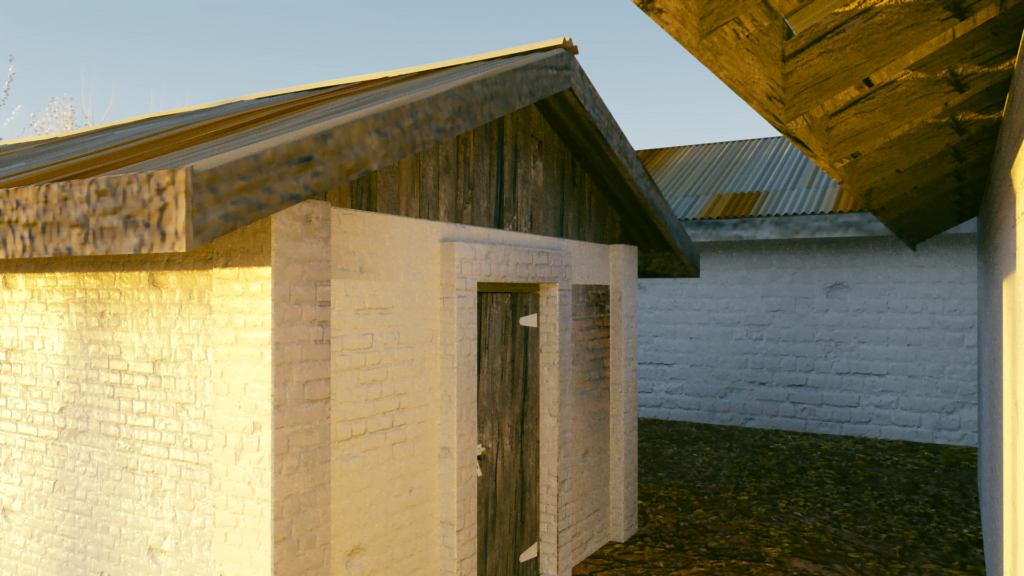
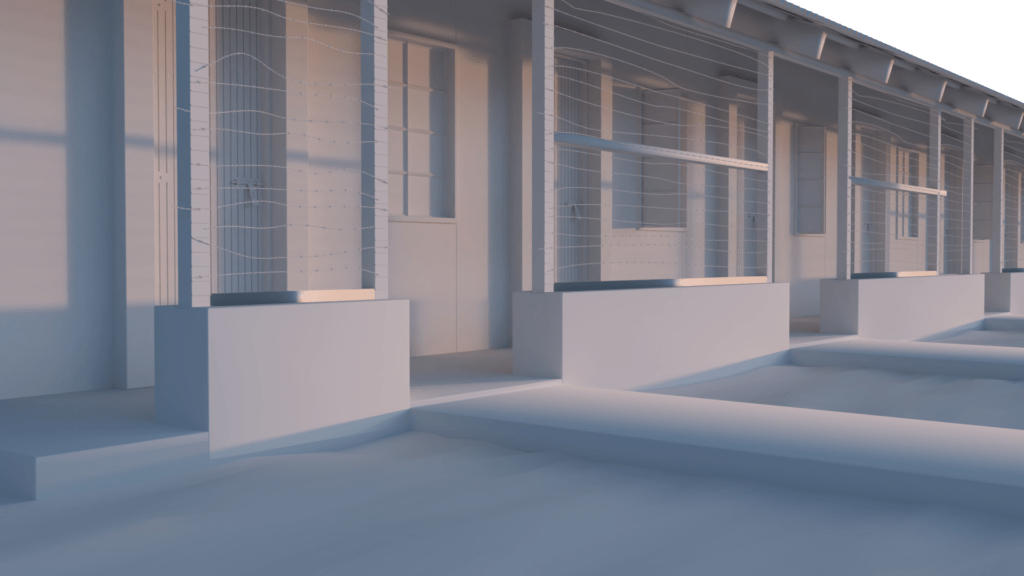
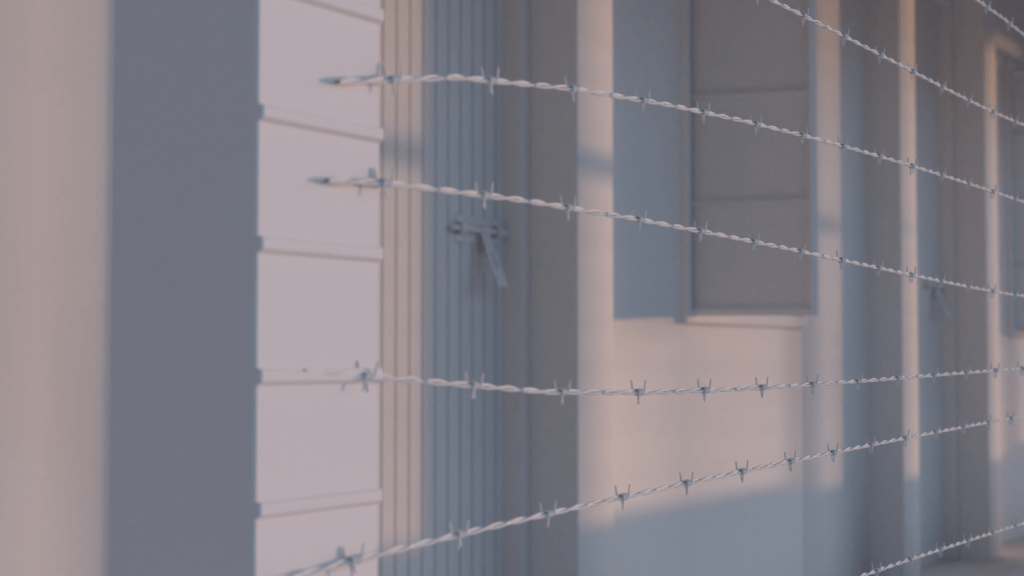
MWERU WORKS CAMP
The former torture chamber at Mweru High School is still standing in largely the same condition as it was when the camp was in use. The images below illustrate two key stages in our reconstruction process. The first images depict a white, untextured model showing the reconstruction in its earlier stages, where the focus is on the structural elements of the building instead of the aesthetics.
The final image shows a more photorealistic reconstruction that attempts to depict the environment, textures, and colours as they would look in real life.
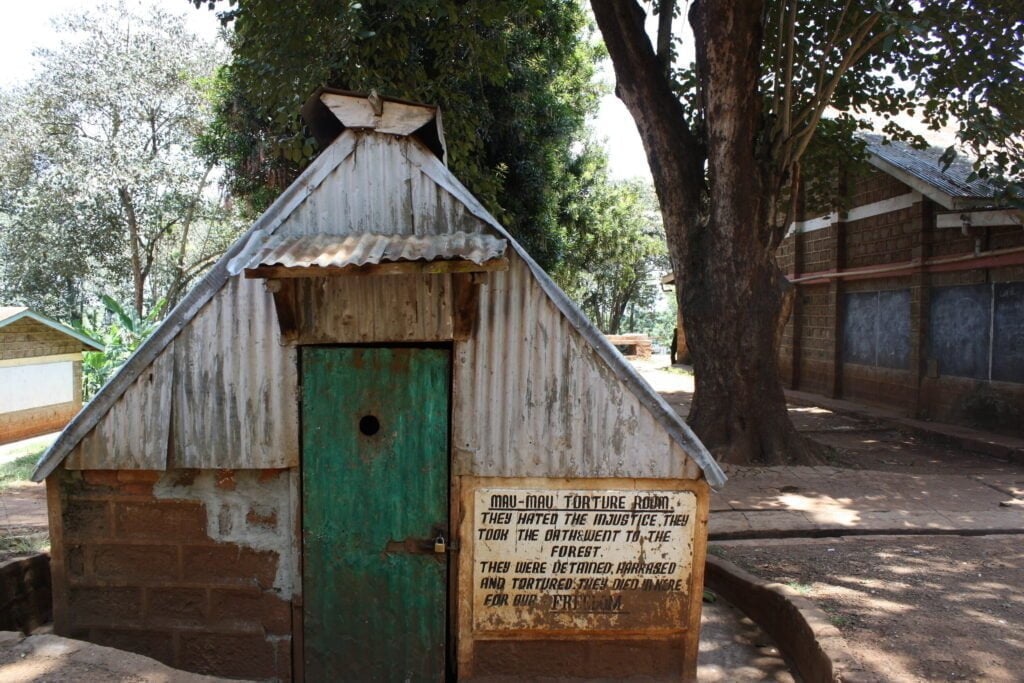

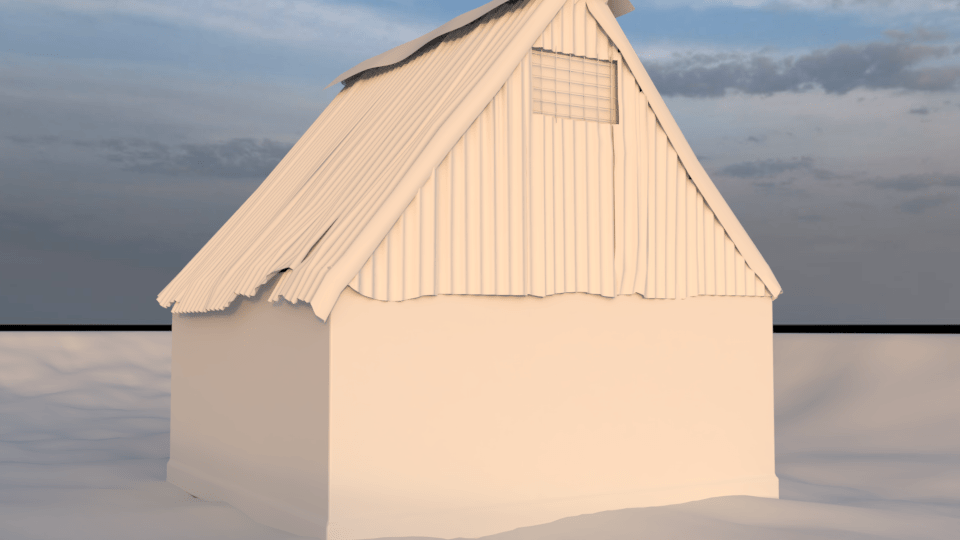
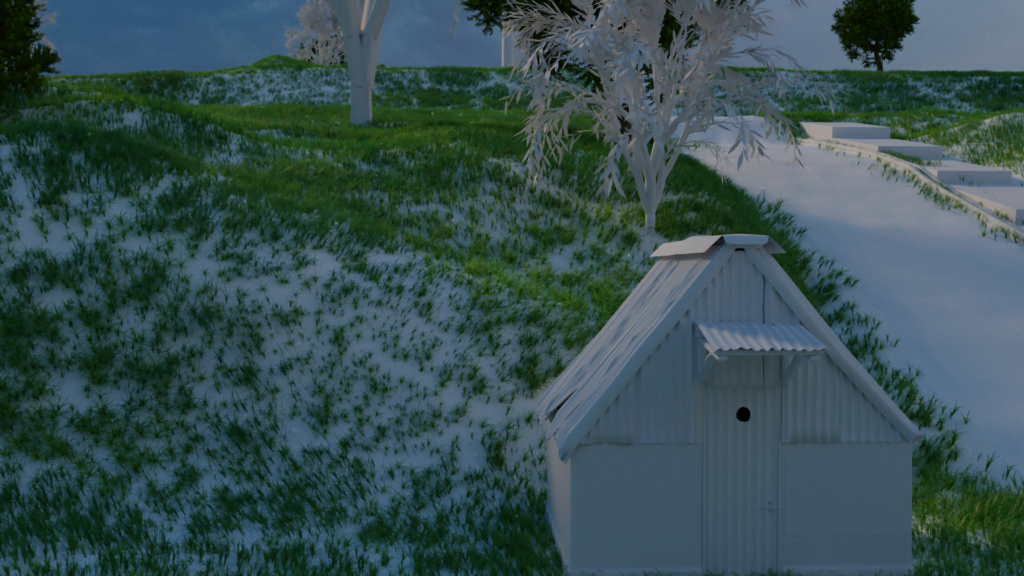
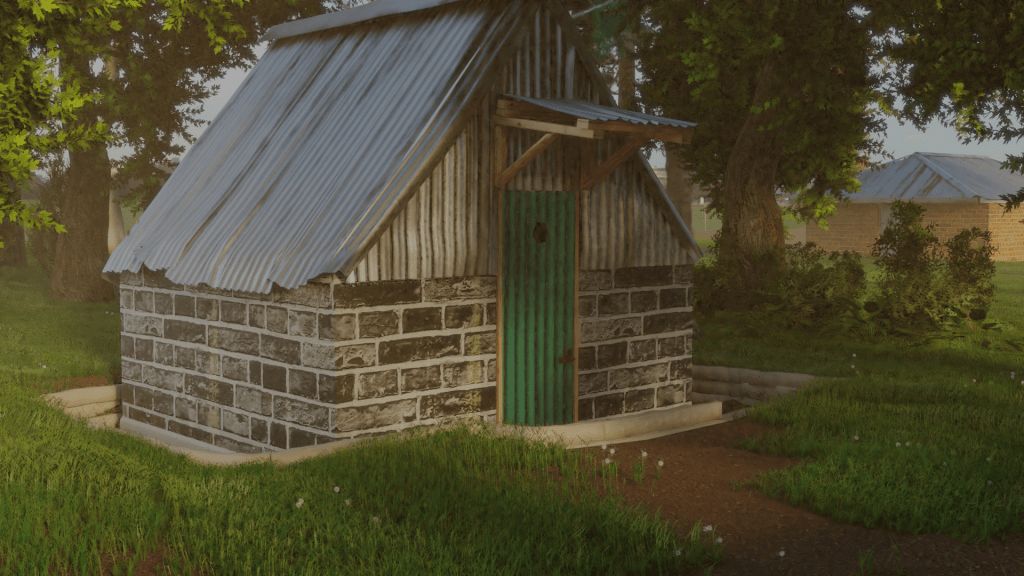
The final model is a 3D digital reconstruction of the mass cells at Mweru Works Camp. As can be seen from the photograph below, the basic structure of these mass cells still exist today. However, oral history interviews alerted our team to the fact that some alterations were made to the cells in order to repurpose them for use in the school. The primary alteration was the addition of windows to let light in, so that the space could be used as a classroom. This contrasts significantly from the windowless space used to house suspected Mau Mau sympathisers.
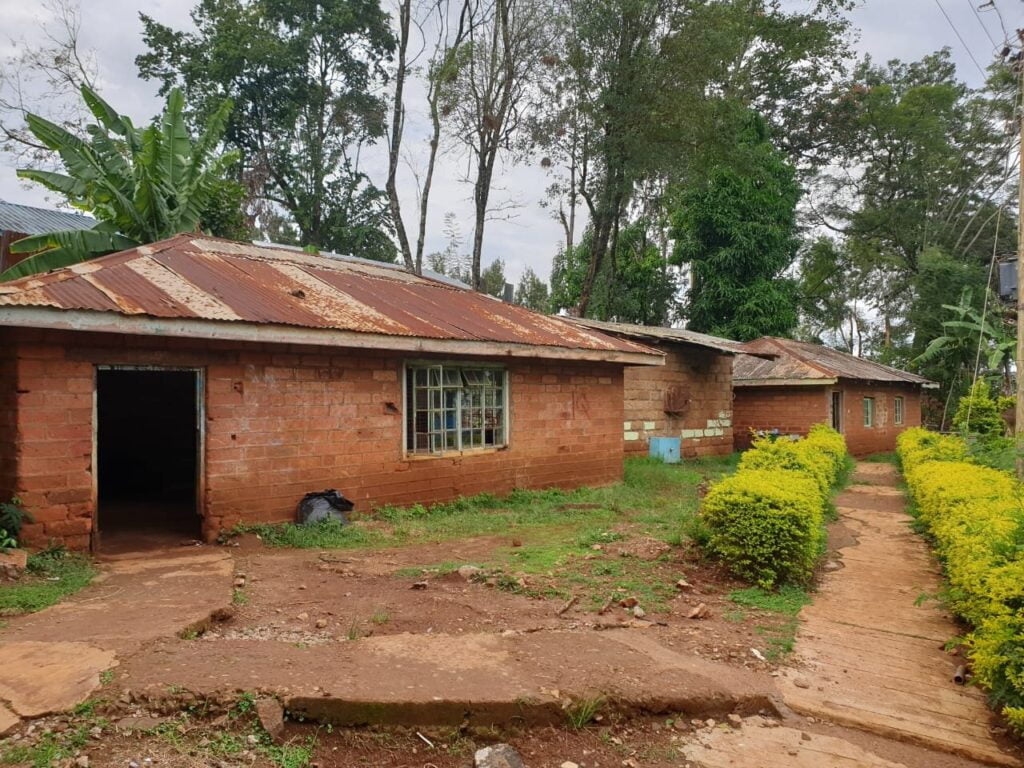
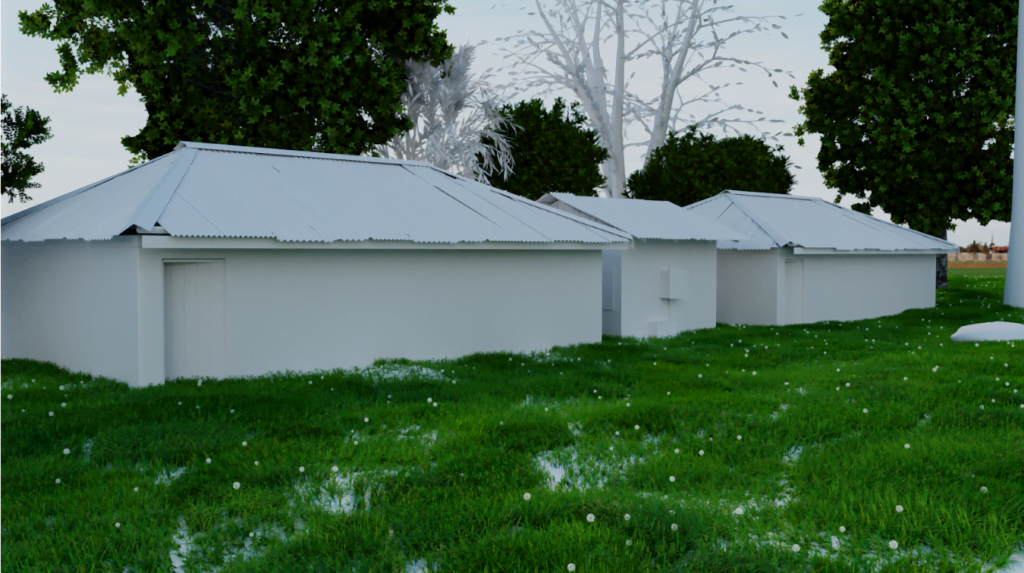

KIAMBICHO VILLAGE, SAGANA
EMERGENCY STORIES
Since we first began MBC in January 2018, privileging and centralising the experiences of men, women, and children who lived through the Mau Mau Emergency, and bearing witness to their experiences, has been a central part of our approach. Our team has therefore been visiting veterans of the Mau Mau Emergency and British detention camps to listen to and record their stories.
We believe that by sharing more of these stories, we will contribute to a richer and more rounded history; one that prioritises the accounts and observations of those who have experienced the impacts of colonialism worldwide – not just the accounts of those who have studied it. This form of engagement is more direct, more personal. It is also an act of recognition; recognition of the fact that British colonialism didn’t just shape certain countries in a structural, political, or abstract way – it shaped every single life it touched. And, in many ways, continues to do so, even today.
We are delighted to share three stories documented by our team and shared with the full consent of the individuals featured: James Njuguna Mwaura, Muthoni wa Kirima, and Wambugu wa Nyingi. Click on each image to view/listen to the interviews, or see below to read transcripts.
JAMES NJUGUNA MWAURA
James Njuguna Mwaura was twenty years old when the Mau Mau Emergency began. He joined the Mau Mau to fight for Kenya’s freedom and he took the Mau Mau oath. He was arrested and detained in Karatina Detention Camp for four years, surrounded by barbed wire so high they couldn’t reach. He and his fellow detainees were interrogated but not willing to give answers, even if they were mistreated. During the historic court case in 2011, James showed the scars on his back from where he had been beaten.
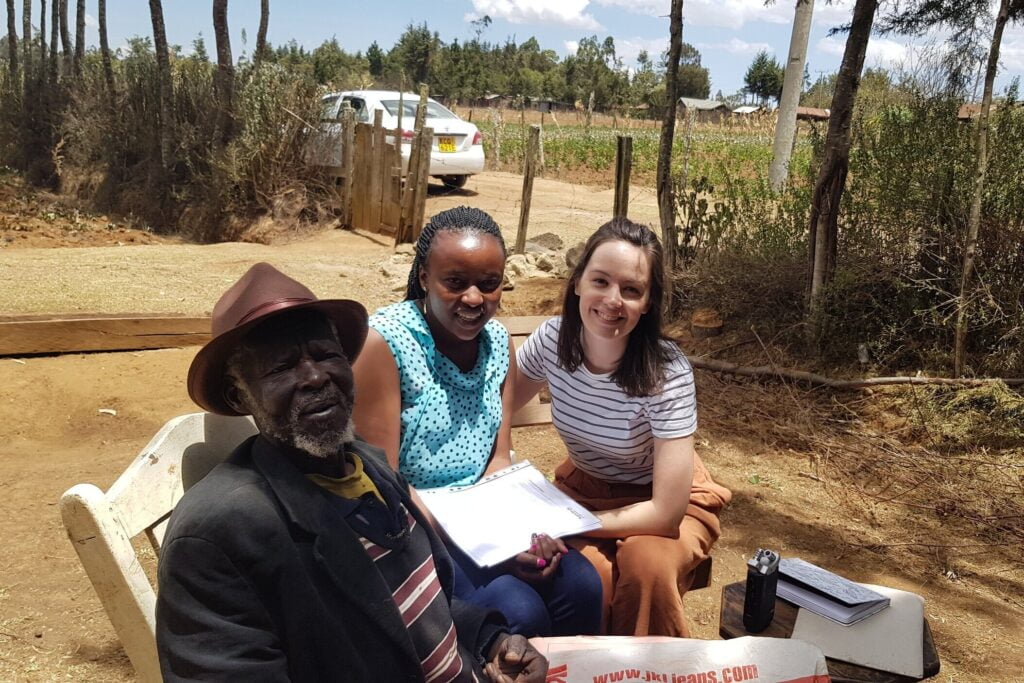
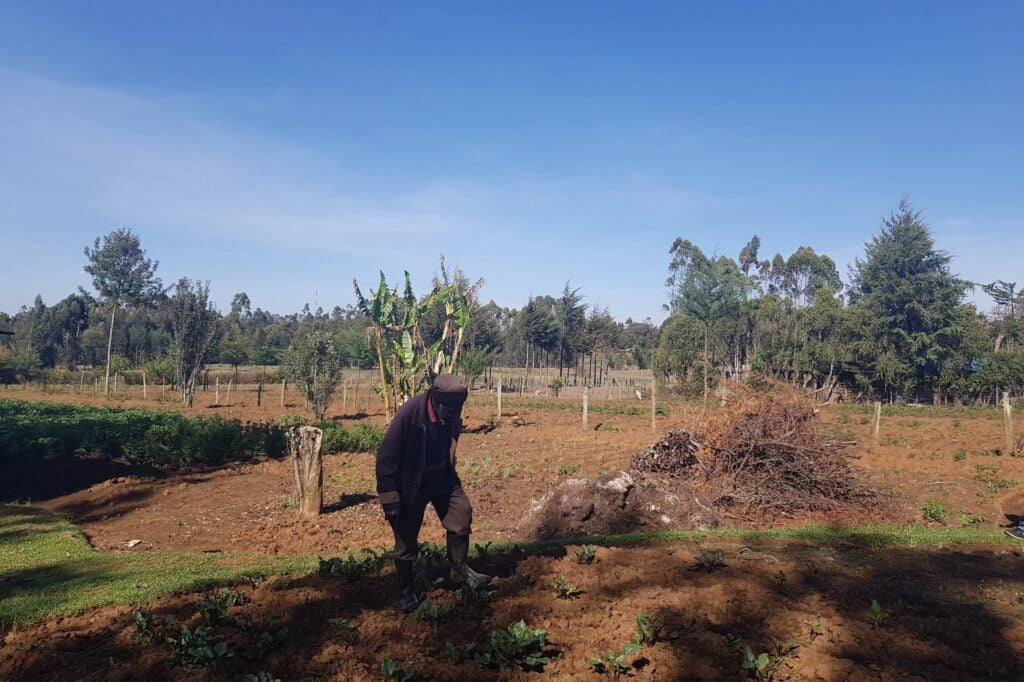
MUTHONI WA KIRIMA
Muthoni wa Kirima was born in 1932 and was a top-ranking female fighter in Mau Mau Emergency. She fought in the forest for the duration of the Emergency was the only woman to attend the rank of field marshal. Muthoni was never held in detention, and emerged from the forest to celebrate Kenya attaining independence in 1963.
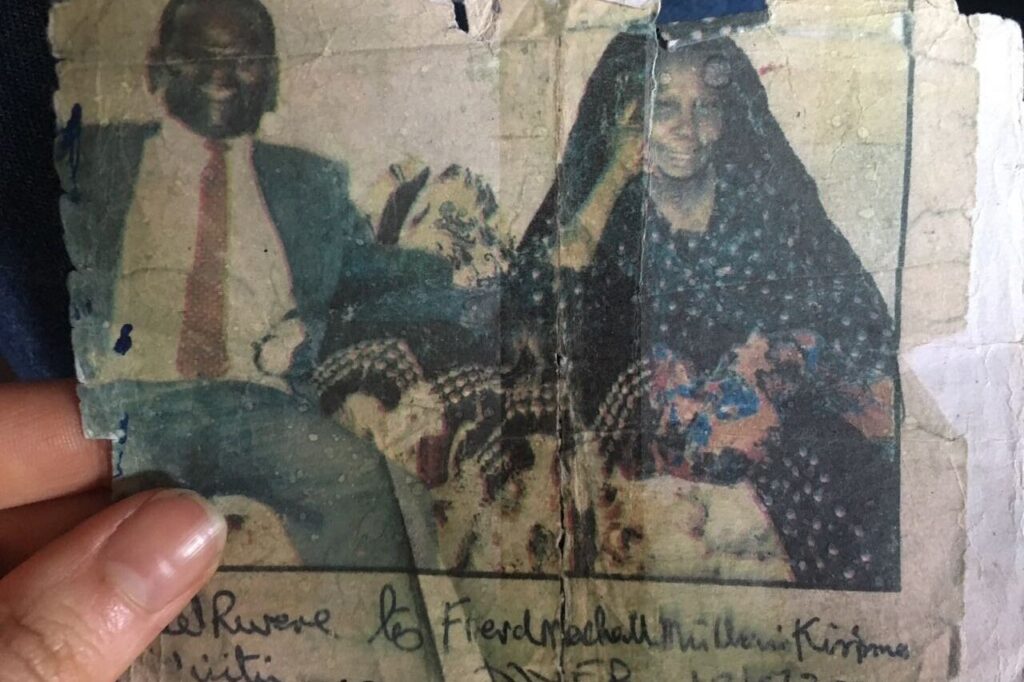
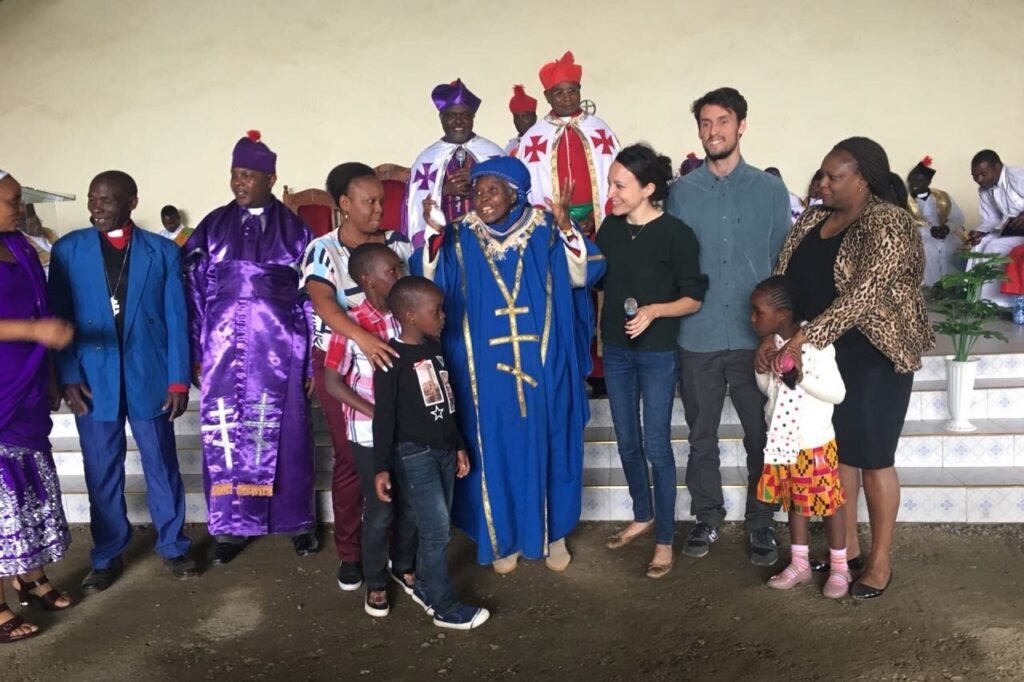
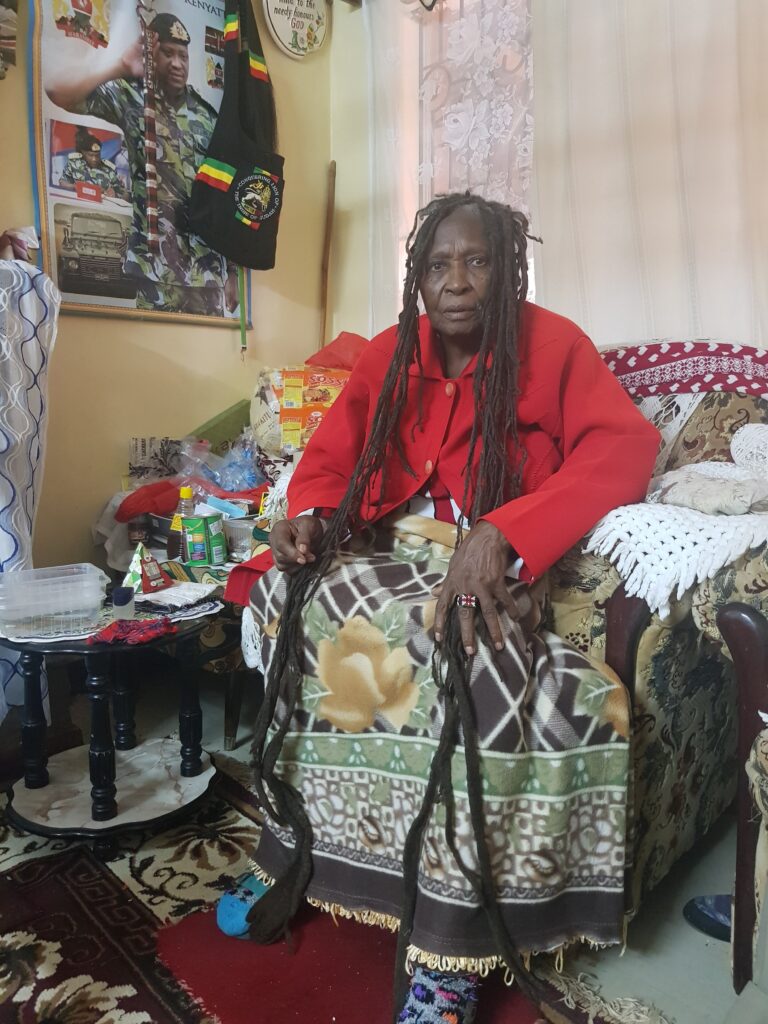
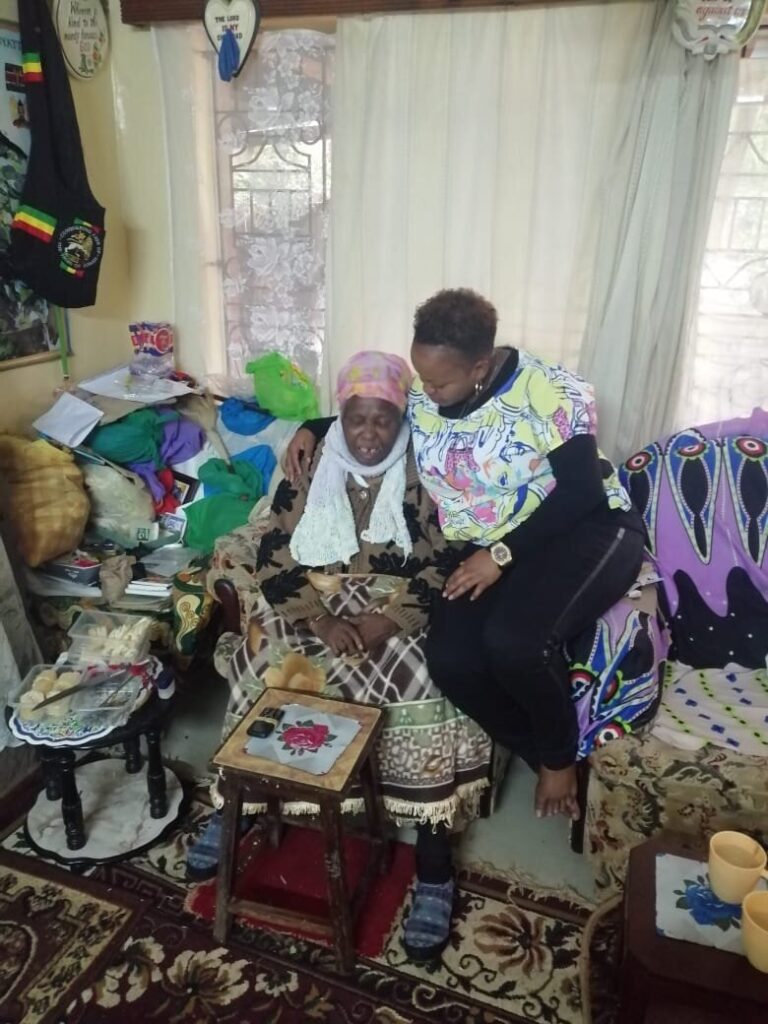
WAMBUGU WA NYINGI
The British colonial administration arrested Wambugu wa Nyingi on December 24th, 1952 on suspicion of taking the Mau Mau oath. Wambugu was held at sixteen colonial detention camps during the Emergency; in this time he experienced beatings, starvation, and squalid living conditions.
During the infamous Hola Massacre, Wambugu was presumed dead for three days until the coroner found him alive. In the video interview our team conducted with him, Wambugu speaks to the Museum of British Colonialism about his life and experiences during the Emergency. His story moves from his childhood and memories of the stirrings of rebellion, to his time in detention camps across Kenya, and finally his return to his mother’s home in Nyeri after being long presumed dead.
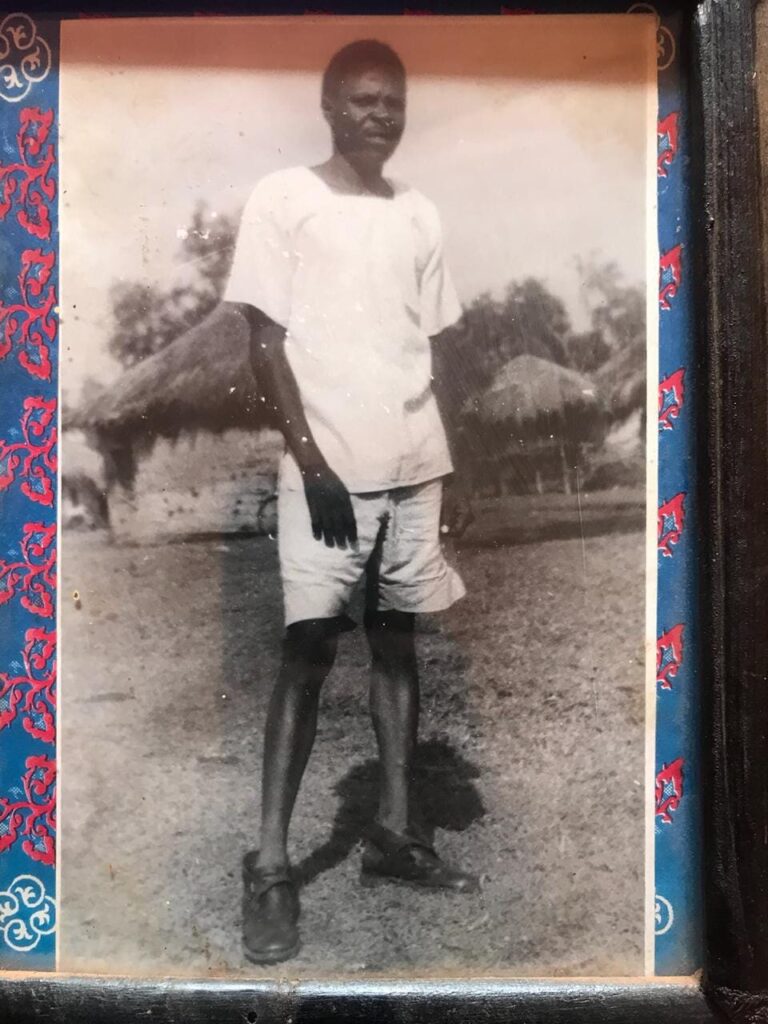
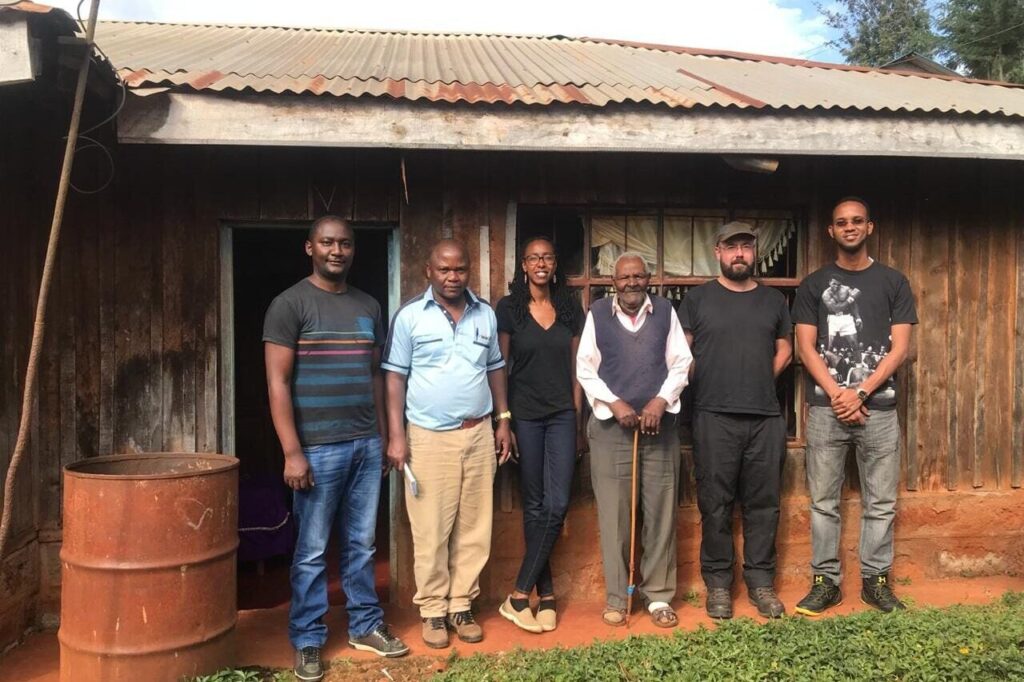
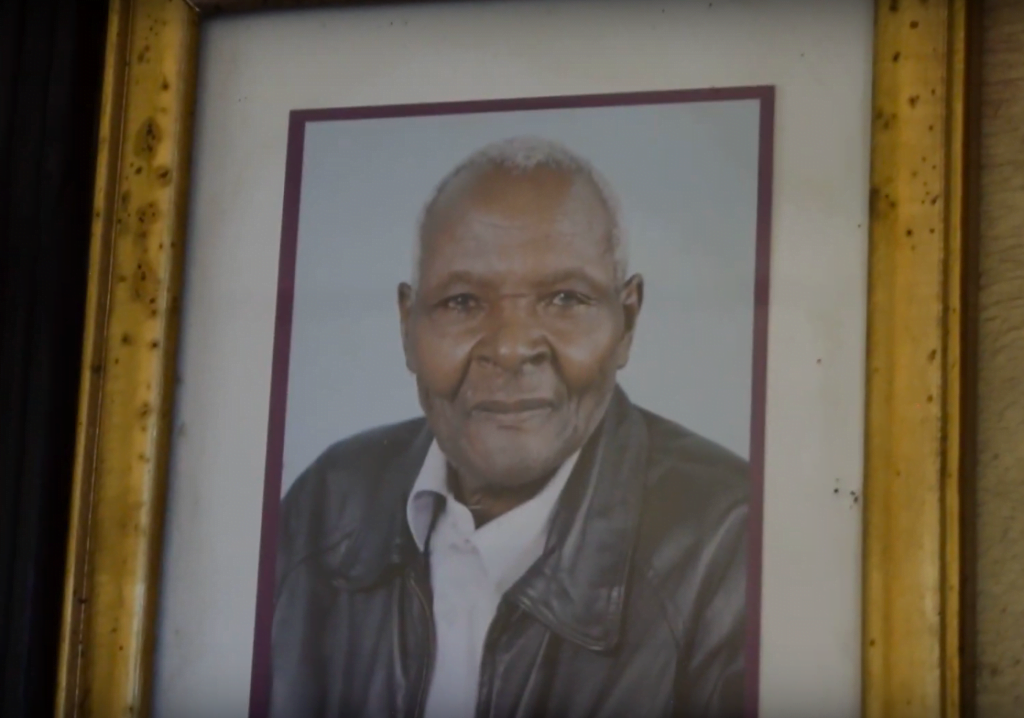
GITU WA KAHENGERI
In the 1950s, Gitu wa Kahengeri took an oath in support of the Mau Mau freedom movement. He was subsequently arrested along with his father and sent first to Athi River Camp and then to Takwa Detention Camp on Manda Island. In total, Gitu underwent seven years of detention and forced labour. He has been a central figure in the Mau Mau quest for justice and continues to represent veterans and victims of torture as President of the Mau Mau War Veterans Association.
Gitu’s oral history interview was published in August 2020 and was not part of the Changing the Narrative exhibition.
